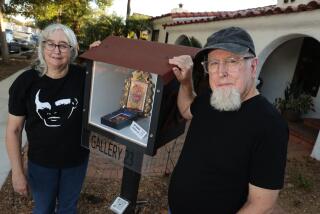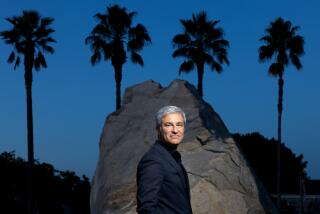6-Member Museum Board Resigns to Protest Jazz Series
LONG BEACH — Less than a month after being shaken by a controversy surrounding the dismissal of a longtime employee, the Long Beach Museum of Art has experienced another jolt in its unsteady relations with volunteers and patrons.
Citing unhappiness over the museum’s handling of a summer concert series, the museum council’s six-member board of directors has resigned en masse.
“We felt that we had lost our effectiveness,” said George Metivier, chairman of the council, a group of volunteers charged with increasing museum attendance and attracting members. “We didn’t have much heart to do anything more.”
In a city struggling to bolster its image as an arts center, the fracas is the latest in a series of noisy setbacks that are likely to have an impact. Hanging in the balance, among other things, is the museum’s announced desire to move to an expensive high-rise downtown, a plan that would require a great deal of fund-raising by museum volunteers.
Until recently, one of the council’s major functions was to help in the overall fund-raising effort by organizing an annual Wednesday night summer Sunset Concert Series, a mix of outdoor programs that since 1986 has featured everything from classical to folk music.
Although the council has no direct power over administrators, who report directly to the museum foundation’s board of directors, the group has played a major advisory and organizational role, particularly in the areas of attendance and membership.
Last year, Metivier said, an average of 200 to 300 people attended each concert, with museum members getting in free and non-members paying $3. The result: 50 new members and a profit of about $4,000.
This year, however, museum directors decided to change the format. Instead of having the museum council organize the series, press officer Jon Moynes said, the museum is presenting the series in conjunction with KLON, a public radio station affiliated with Cal State Long Beach. And instead of offering a mix of musical genres, he said, the series will have only jazz, which is the radio station’s specialty.
By relying on the added publicity afforded by the station and increasing prices to $3 for members and $5 for non-members, Moynes said, the museum--after splitting the proceeds with KLON--hopes to realize a profit of at least $10,000.
“We felt it was an opportunity to bring music of a different order of quality than we’ve had in the past,” Moynes said. “It just seemed like a wonderful idea.”
Metivier and the five other council leaders, however, disagreed. First, Metivier said, they were deeply offended at being excluded from high-level participation in an event that they saw as their major reason for being. And second, he said, they believe the series as now planned will be less representative of the eclectic mixture of tastes that the museum is supposed to serve.
“We have enough jazz in this city already,” Metivier said. “This has shifted the emphasis into ‘let’s get money.’ They seem to be losing the humanity and the community interest.”
Moynes denies that the council was excluded from participating in the series’ development, saying that they were asked to provide comment but declined.
And museum director Stephen Garrett said that while it is unhealthy for the museum to lose a group of such “interesting, alert and intelligent” volunteers, the institution’s basic character has not been distorted because of a profit motive or for any other reason.
According to Metivier, however, it was not just the handling of the concert series that alienated his group, which besides himself consists of Terry Callahan, Sue Ahrend, Karen Riley, Lisa Broder and Cass Humphrey. In addition, he said, they were upset over the firing last month of Barbara Hendrick, manager of the museum’s bookstore and gallery. After 23 years of employment and eight months before her 65th birthday, her job was eliminated in a reorganization aimed at making the store more profitable.
The firing drew a barrage of criticism from patrons, some of whom canceled their memberships, and raised questions regarding the museum’s ability to maintain the good public relations necessary to procure financial contributions.
The issue is particularly significant in light of the suggested move from a quaint brick building overlooking the ocean to a proposed 31-story downtown office building, a plan that would require the raising of several million dollars.
That plan has inspired some organized opposition among museum supporters.
“It’s a concrete and glass structure,” said Earl Birch Smith, a retired aircraft engineer and part-time artist who says he is spearheading a letter-writing campaign aimed at derailing the move. “I don’t see it as a healthy place.”
More to Read
The biggest entertainment stories
Get our big stories about Hollywood, film, television, music, arts, culture and more right in your inbox as soon as they publish.
You may occasionally receive promotional content from the Los Angeles Times.










